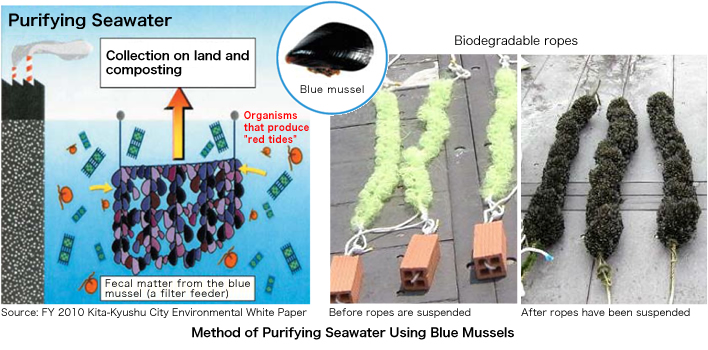Sato-umi and Substance Circulation
![]()
Long, Broad and Smooth Circulation of Substances Nurtures Sato-umi
The rain that falls in the forest collects in leaves and muck soil. In this process, nutrients dissolve into the water, which then flows slowly via rivers into the ocean. In the ocean, these nutrients are used by phytoplankton, seaweed and other forms of life and are passed on to zooplankton and fish and other sea creatures through the food chain. The fish are then caught by fishermen or eaten by land animals, or they swim upstream to spawn. In this way, through these or other means, they return to the land once again. This perfect balance of forest, river, sato and sea creates a healthy circulation of materials.

Current State of Substance Circulation (Forest, River, Sato and Sea) and Issues to be Resolved
When forests are cut down, rain erodes the topsoil in the mountains, and muddy water containing no nutrients flows through rivers into the sea. This reduces the biological productivity in the ocean, resulting in rocky-shore denudation, discolored nori (laver), reduced fish catches and so on. In Okinawa Prefecture, wetland development, river improvement projects and so on sometimes cause red soil to flow into the ocean, causing major damage to coral reefs.
Large quantities of factory wastewater and sewage that are the result of human activities also flow into the ocean. The excessive nutrients in the ocean cause major propagation of phytoplankton, resulting in "red tides." When a red tide occurs, most of the organisms die and settle on the ocean floor. This prevents nutrients from being transferred to zooplankton and other organisms and results in a shorter substance circulation. In addition, the phytoplankton that settle on the ocean floor are broken down by microorganisms, and large quantities of oxygen are consumed in this process, reducing the amount of oxygen in the water that is needed to support marine life.

A variety of efforts aimed at building healthy substance circulation are underway in various locations.

If dams and weirs are present, they prevent fish from swimming upstream to spawn, and they also reduce the provision of the sediment needed to maintain tidal flats and shallows. When this happens, the nutrients are consumed by the phytoplankton in dammed lakes and do not reach the downstream areas, with the result that the circulation of materials is cut off. For this reason, efforts such as providing dams and weirs with fishways, periodically discharging soil and water at dams and so on are being conducted to ensure proper management.
Many of the pollutants that flow into the sea are the result of human activity. Of the pollution (chemical oxygen demand or COD) that is discharged from land areas and flows into the Seto Inland Sea, 40% is household wastewater and 50% is runoff from industrial activities. For this reason, efforts to reduce pollution by means of sewage treatment plants and so on are underway in various locations. It is also important to devise ways to reduce the pollutant content in wastewater from each household, by using appropriate amounts of detergents, reusing oil multiple times and so on.
Efforts are underway to use the purifying capabilities of living organisms in order to keep the ocean clean.
In Dokai Bay in Fukuoka Prefecture, a project to eliminate nutrient substances using murasaki-gai (blue mussels) is underway with the cooperation of local elementary schools and so on. Blue mussels attached to hanging ropes are used to absorb nutrient salts from the ocean. Then the blue mussels are collected on land and used as compost.
In Toyama Bay in Toyama Prefecture, the fishers are aiming at the purification of the coastal water using the seaweed’s nutrient absorption function.
Efforts to maintain fish catches that are appropriate for the ecosystem in each ocean region and cultivate nori in nutrient-rich ocean regions are also playing an important role in removing nutrient substances from the ocean.














